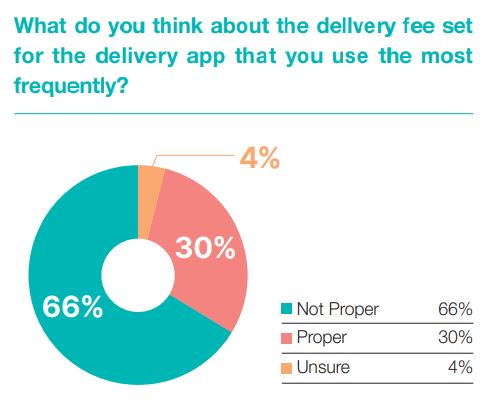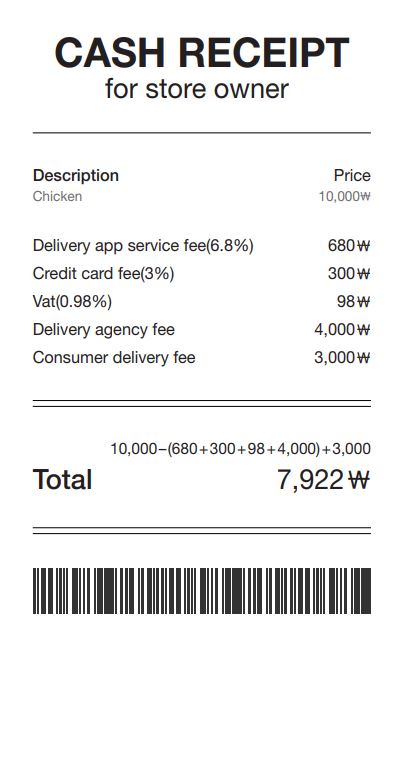
Picture this: a college student opens up a delivery app to order delivery food for lunch. For a moment he is excited, expecting a delicious lunch, but soon after he looks at the check, and his face turns dark. The delivery fee was as much as the cost of the meal itself!
Have you ever experienced something similar when ordering delivery food recently? According to Statistics Korea, the amount of transactions in the online food service industry increased 2.09 times after the COVID-19 outbreak. However, amid the growing delivery demand, the increasing price of the delivery fees are troubling.
- Soaring Delivery Fees Burdening Customers

According to the delivery field, when using delivery platforms the average delivery fee per order recently is about 6,000 won.* It is nearly double the average delivery fee of 3,394 won in 2020, which was surveyed by the Ministry of SMEs and Startups. In a survey of a thousand Korean citizens conducted by Hankook Research, 66% of the respondents said the current delivery fee is outrageous. Due to the high delivery prices taking a toll on people’s wallets, new takeout cultures are popping up. People are instead ordering take-out from the stores, and pooling their money to split the expensive delivery fees. Despite such widespread negative perceptions of high delivery fees, some delivery platforms are continuously raising the delivery and commission fees.
*Official blog of Ministry of Economy and Finance (https://blog.naver.com/mosfnet/222638699296)
- Various Reasons Why Delivery Fees are Increasing
What is causing the increase in delivery fees? There are various reasons why.
First of all, the competition to secure delivery workers among delivery platforms has intensified. In the past, delivery workers used to deliver several orders at once to increase work efficiency. However, large delivery platforms have started to offer one-at-a-time delivery in the name of improving the delivery quality, which has resulted in a delivery worker shortage. Therefore, platforms started to provide promotions such as paying additional wages per order to attract delivery workers, which led to an increase in delivery fees.
Meanwhile, Baemin One and Coupang Eats, the delivery services which deliver only one at a time, ended their promotions and made changes to the fee system recently. Both services had a delivery fee of 5,000 won while promoting, but when the promotion ended, the delivery fees increased to 1,500 won and 400 won. In the process, however, consumers failed to receive a proper notice of the increased delivery fee. Kang Bo-mun, who was a delivery worker for about four months, mentioned that he feels that the delivery fees have leaped “even as a delivery worker.” He said, “the delivery fee is higher than the food price in some cases. I think it will be important to give a clear explanation of how the delivery fee is decided when the customer makes an order.”
As Baemin changed their criteria for calculating the delivery distance in April based on the driving route, worries over delivery fee increases are spreading among the customers. Since the new delivery distance is likely to be longer than the previous criteria of a straightforward route, delivery fees paid to delivery workers are also expected to increase.
- Voice of Delivery App User
An anonymous JBNU student, a VIP-grade user of the delivery app, Baemin, explained why she uses the app all the time. She said, “first of all, there are many stores on the app. From fast food to dessert, anything I want. Stores even hold review events to compete with each other. For consumers like me, I can benefit from getting free food by giving five stars and writing a short review. Baemin also offers discount coupons. I can only use them for franchise stores, but that doesn’t matter to me.”
However, she also mentioned disadvantages of using the app, and the high delivery fee was number one on the list. “In some cases, the delivery fee is even higher than the price of food itself. When that happens, I often just give up on what I want to eat.” She also complained about the app’s take-out fee. “I used to order take-out on Baemin to save on delivery fees. However, I did not know that a take-out fee exists. One of the shop owners I often ordered food from explained it to me.” She said she felt cheated after she knew about the take-out fee and is trying not to order take-out on delivery apps anymore. “I think the companies should put the correct information about the fee on their apps.”
- Consumer and Store Both Pay for Delivery
Back when Chinese restaurants delivered food for free, stores hired delivery workers of their own. After the universal use of delivery apps, delivery orders have skyrocketed. Delivery agencies efficiently allocate delivery workers, handling endless orders on time. Currently, there are as many as six stages in the delivery process: the consumer, the delivery app, the store, the delivery agency app, the delivery agency, and the delivery worker. Baemin and Yogiyo are delivery apps that connect consumers with stores. Delivery agency apps like Barogo link stores with delivery agencies. Relatively new to the system, companies such as Baemin Connect and Coupang Eats crowdsource delivery workers, instantly linking them with stores through delivery apps.

The delivery fee covers mainly three things: the delivery worker income per delivery, the delivery agency fee, and the delivery app fee. Both the consumer and store owner pay for the delivery fee, and the store owner decides how much the consumer will pay for their delivery.

In the case of Baemin, store owners can choose between several delivery app services. The most frequently used is ‘Openlist Service’ which has a 6.8% delivery fee per product price on openlist orders. In the case of a 10,000 won chicken, a 6.8% fee is for delivery app services, 3% is for credit card fees and 0.98% is for VAT (value-added tax), while the delivery agency fees can vary. Delivery agency fees range from 4,000 won to more than 9,000 won during peak hours, bad weather, long distance delivery, and holidays. If the delivery agency fee is 4,000 won and the consumer pays 3,000 won, the shop will earn 7,922 won. Since this must cover labor costs, rent, packaging, and ingredient costs, not much is left for the shop owner to keep.
- Store Owner Speaks Out about Delivery

The JBNU Globe interviewed Hwang Gil-won, the owner of MyMy Chicken, who used delivery apps for seven consecutive years.
Q. How do you feel about the increasing delivery fees?
A. I think it’s inevitable, considering the increased demand and the amount of tax for delivery workers. As a store owner that uses delivery agencies, the increased delivery fee rate of 20% made me raise the delivery fee.
Q. MyMy Chicken has a noticeably low delivery fee of 900 won as of March. Do you have any reasons as to why?
A. I mainly had in-store orders but I began delivering as a service for students who want to eat at home. For six years I delivered for free to lighten the load on students. At one point I set the fee for 500 won for a while, but the increased delivery fees and ingredient prices made this impossible”.
Q. Between delivery and take-out, which do you prefer?
A. I prefer take-out, as it is beneficial for both the store and the consumer. I can give take-out discounts and offer free food. It’s also a joy for me to meet customers and have small talk.
Q. Do you have any requests for delivery apps?
A. I wish they would narrow down the local areas of advertisement. Since stores from far away advertise near JBNU, stores near JBNU also need to advertise to make themselves appear on top of the delivery app list. The competition is way too heated. Furthermore, I wish delivery apps would ban review events. I am not doing it myself, but I’ve heard from other store owners that half of the customers don’t leave reviews after receiving event items. Stores have no choice but to join in, however, because every other store is doing it to get five-star ratings and a higher number of reviews. I personally think it would be better if customers earn 50 to 100 won per review.
Q. Do you have anything else to add?
A. You can eat warm food quickly if you are in a 1 to 1.5km radius. Even if you are nearby, delivery workers take nearly three orders in peak hours. The further you are, the more stops, leading to late delivery and cold food.
- How to Escape from the Delivery Fee Nightmare
Have you heard of the ‘JBNU Dormitory Delivery Room’? This is a chat room created by students who are burdened by delivery fees. Students who want to eat delivery food gather to order it, and the delivery fee is divided fairly.
In order to reduce delivery fees, the government has implemented a delivery fee disclosure system since February. The government will disclose delivery costs through the platform to induce price competition. In fact, the Korea National Council of Consumer Organization announced the results of the February Delivery Cost Pilot Survey on February 13th. However, this was limited in the Seoul area, and the menu only consisted of Tteokbokki and chicken. Some point out the effectiveness of the system, while others say it is meaningless to re-collect and display what has already been released on delivery apps.
The answer to the soaring delivery fees can be found in the ‘public delivery app’, created and operated by local governments. It is designed to reduce delivery fees for local small business owners and provide various benefits for citizens.

In Gunsan, a public delivery app called ‘Master of Delivery’ is being used for the first time in Korea, and an app called ‘Wolmaeyo’ is used in Namwon. Especially in Gunsan, the biggest feature is that the owners of the stores do not have to pay a fee to the platform. Consumers can also get discounts by using Gunsan Sarang Gift Certificates. In ‘Wolmaeyo’, owners can use the platform at a lower price. Additionally, it has a cashback event where consumers can receive 1,000 won points per order. Following in the footsteps of these successful regional apps, Jeonju also launched the ‘JJorder’ app in February. As of March, the cumulative number of ‘JJorder’ subscribers were 18,998 and registered stores were at 1,206, garnering much attention.
So what are the actual users’ opinions? The JBNU Globe heard the thoughts of an anonymous JBNU student, referred to as ‘A’, who has been using JJorder since February when the app was launched.
In early February, ‘A’ found out about the app through a street banner that said it was recruiting restaurants for JJorder.
“I mainly ordered delivery using Baemin. The expensive delivery fee was a waste, but there was no other way.” Due to the high delivery fee of large delivery apps, ‘A’ started to use JJorder. However, she added that there were only a few registered stores, due to the recent launch. “My favorite store was not registered. I was disappointed that there were only a limited number of stores that I could order from.” It is true that the number of registered stores for JJorder is smaller than that of large delivery apps. However, JJorder is still in the early stages and owners are steadily registering their stores. In fact, the app continuously updates the recently registered stores on the main page. “Still, I liked the benefits such as many discount coupons, first sign-up coupons, and delivery fee coupons to celebrate the opening.” As ‘A’ said, JJorder is currently planning more events and is trying to capture the hearts of both store owners and consumers.

In order to find out more about the efforts of JJorder, the JBNU Globe requested an interview with Jang Woo-sang, who works as a researcher at the Jeonju Information Culture Industry Promotion Agency.
During the interview, Woo-sang mentioned the various benefits of JJorder. JJorder provides free advertising, free entry, and no brokerage fees for store owners. From a consumer’s point of view, there is also a benefit of receiving 10% cash back when paying with local love gift certificates. He added, “I think the biggest difference is that small business owners and citizens in Jeonju are contributing to revitalizing the local economy by using these apps.”
Next up for JJorder are several upcoming events. In April, seminars will be held for store owners who registered with JJorder. The promotion agency plans to hold promotional contests using videos with JJorder commercial songs for Jeonju citizens, JJorder Instagram cartoons, and JJorder slogans. “We are also planning events on Children's Day, Parents’ Day, and Teacher’s Day in May, so please pay it a lot of attention.”
He added, “for two days from March 24th to 25th, JBNU’s central club ‘Kkun’ helped actively promote JJorder. We would like to continue promoting and holding events together. Other than ‘Kkun’, students with unique and fresh ideas should contact us anytime. We ask for your active engagement with this promotion.”
| Kim Eun-ji Editor-in-chief, Chin Da-youn Editor, Park Ji-woo Reporter

